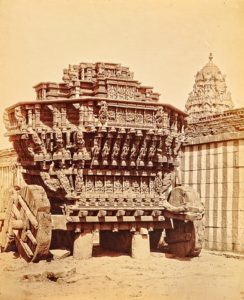By Pamela Toler (Regular Contributor)
In the twelfth century, an Indian ruler built an important temple at Puri, in modern Orissa, where the Hindu god Krishna was worshiped in the form of Jagannatha (Lord of the World). The most important of the annual festivals associated with the Jagannatha temple was the Chariot Festival. The god’s image was placed in a highly decorated wagon and taken on procession from the temple to the country house of the god. The wagon was so heavy that it takes hundreds of worshipers to move it. The procession was accompanied by thousands of pilgrims, who crowd around the wagon. Between the crush of the crowd and the weight of the wagon, accidents were common. Occasionally an ecstatic pilgrim threw himself under the wagon’s wheels.
Quiet devotions by individual worshipers don’t make much of a story. Huge crowds and an inexorable wagon that crushes worshipers under its wheels? The stuff that travelers’ tales are made of. As early as the 14th century, European travelers in India were fascinated by the story of the Chariot Festival, and the worshipers who “cast themselves under the chariot, so that its wheels may go over them, saying that they desire to die for their god.” (Friar Odoric, c 1321. Just to give an example.)
In the nineteenth century, more than one responsible British official checked the Orissa province records and reported that the instances of death by chariot wheel were greatly exaggerated. It didn’t do any good. The story of the chariot of Jagannatha had become a metaphorical juggernaut, capable of crushing mere facts beneath its wheels.

